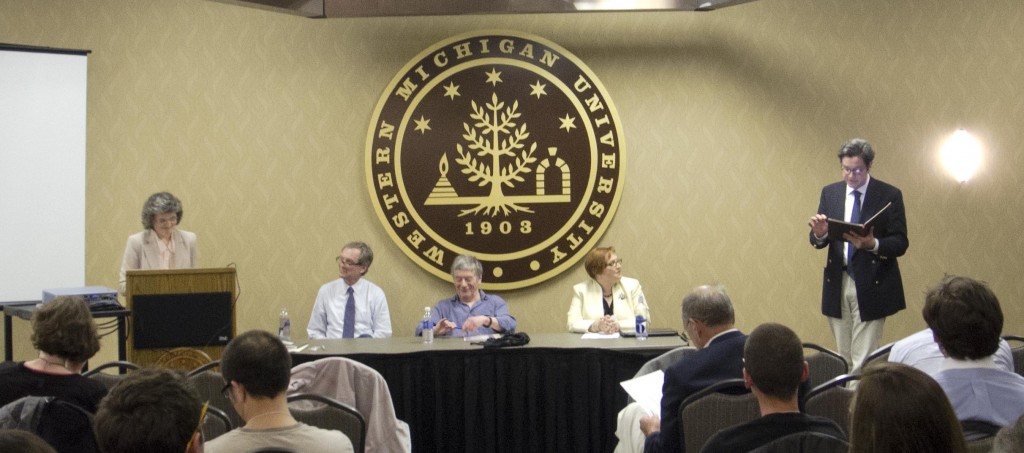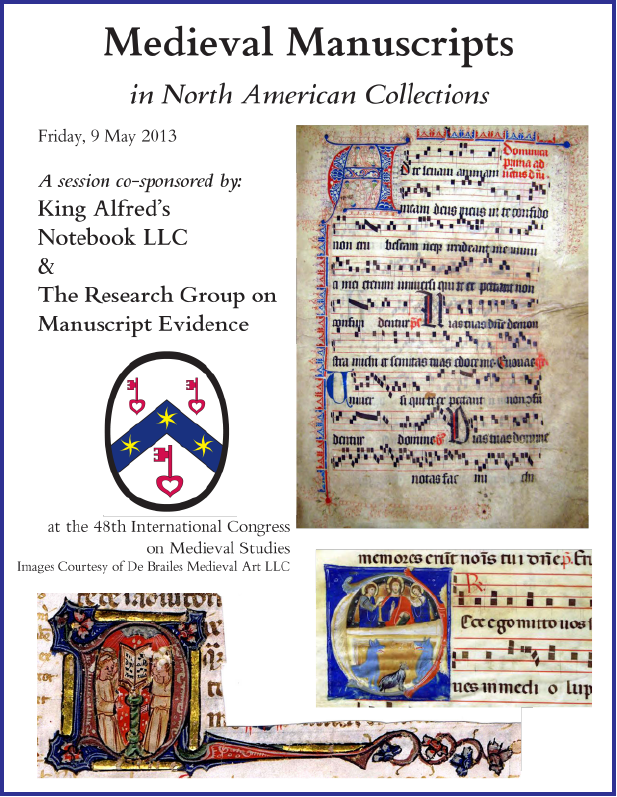2013 Congress
January 1, 2014 in Abstracts of Conference Papers, Bembino, Conference Announcement, ICMS, International Congress on Medieval Studies, Kalamazoo
48th International Congress on Medieval Studies
9-12 May 2013
[First published on our first website on *6 December 2012, with updates there and here]
 With its mission to “apply an integrated, holistic approach to manuscripts and texts in all forms,” at the International Congress on Medieval Studies in 2013, the Research Group on Manuscript Evidence held sponsored and co-sponsored sessions examining the material culture, production, and purposes of written records in Western Europe and beyond, and the dispersal, recovery, and study of those works in various forms and widespread locations. Besides these interlinked subjects, the year’s highlighted genres were astrology, the material technology of magic, and the symbolism of water in the Middle Ages.
With its mission to “apply an integrated, holistic approach to manuscripts and texts in all forms,” at the International Congress on Medieval Studies in 2013, the Research Group on Manuscript Evidence held sponsored and co-sponsored sessions examining the material culture, production, and purposes of written records in Western Europe and beyond, and the dispersal, recovery, and study of those works in various forms and widespread locations. Besides these interlinked subjects, the year’s highlighted genres were astrology, the material technology of magic, and the symbolism of water in the Middle Ages.
As before, we co-sponsored sessions with the Societas Magica and King Alfred’s Notebook LLC (respectively in the eighth and second years of this co-sponsorship). Also, three of our Trustees and many of our Officers, and Associates presented papers at the Congress in a variety of sessions.
Here we report the Programs for our Sessions, publish the Abstracts of their Papers, and illustrate the Posters for the Sessions. For the first time, we designed Posters for all of our Sessions at the Congress, Sponsored and Co-Sponsored. At the 2011 Congress we had one Poster, and two Posters at this 2013 Congress for our Sponsored Sessions, all with images courtesy of David W. Sorenson, whose donation of images inspired their creation. The series of Posters now stand exhibited in our Gallery of Posters on Display. The Posters are set in our own multi-lingual digital font Bembino, available for download for FREE here.
Our tradition of integrating multiple aspects of manuscript studies, embracing the material, textual, historical, cultural, and wider contexts, along with our steady collaboration with other organizations at the Congress, led to the requests for all these sessions. Our dedication to promoting the research work and organizational skills of expert younger and also Independent scholars and teachers gathered wider participation and collaboration. These modes of joining forces across different fields of study, levels of experience, and areas of expertise allowed us not only to marshal our collective abilities, but also to foster rapid contacts between different fields, which might normally take decades. We worked to continue this positive, shared tradition.
The post by Sarah J. Biggs (30 July 2012) to the British Library blog on Medieval and Earlier Manuscripts provides an illustrated announcement for all our sessions: Once More Beneath the Surface. Call for Papers for Kalamazoo 2013. With permission, we reproduce one of Sarah’s selected images for her blogpost. Information about the manuscript containing that image appears online.
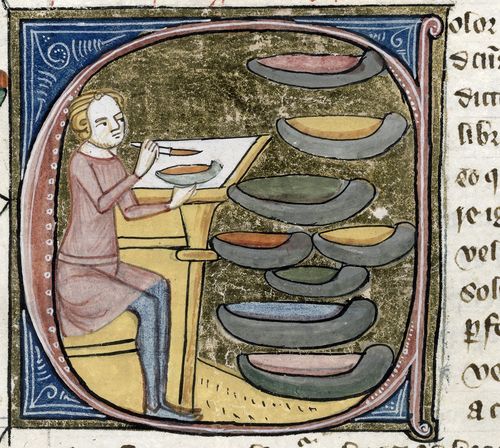
© The British Library Board, Royal MS 6 E VI, folio 396, detail of initial C for ‘Color’ with a scene of mixing pigments. Reproduced by permission
I. Sessions Sponsored by the Research Group on Manuscript Evidence
1. “The Making of Medieval Manuscripts: Analyzing the Materials and Methods of Scribes, Compilers, and Artists”
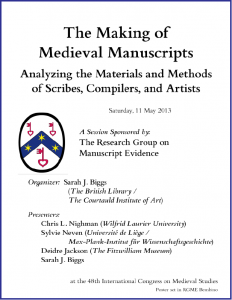 Our session addressed the complex interface between the study of medieval manuscripts and the transmission of knowledge for, and the application in practice of, medieval techniques for preparing their materials, texts, compilations, and illuminations. The papers reported advances in art-historical, textual, philological, and historical analysis of a variety of texts and images, including production techniques, compilation practices, and their transmission across time and place.
Our session addressed the complex interface between the study of medieval manuscripts and the transmission of knowledge for, and the application in practice of, medieval techniques for preparing their materials, texts, compilations, and illuminations. The papers reported advances in art-historical, textual, philological, and historical analysis of a variety of texts and images, including production techniques, compilation practices, and their transmission across time and place.
Organizer: Sarah J. Biggs (The British Library and the Courtauld Institute of Art)
Presider: Mildred Budny (Research Group on Manuscript Evidence)
Presenters:
- Chris L. Nighman (Wilfrid Laurier University)
“Peter of Blois’s Letters and the Manipulus Florum: Editorial Agency in Thomas of Ireland’s Reception of Paris, Bibliothèque nationale de France, Ms. Latin 16714″
Nighman (2013 Congress)
- Sylvie Neven (FRS-FNRS, Université de Liège, and Max-Planck-Institut für Wissenschaftsgeschichte, Berlin)
“Through Artists’ Recipe Books: Knowledge in and Transmission of Late Medieval Illuminators’ Recipe Books”
Neven (2013 Congress)
- Deirdre Jackson (The Fitzwilliam Museum, Cambridge)
“Pigment Analysis on a Low Budget: Low Tech / High Yields with a Digital Camera”
Jackson (2013 Congress)
- Sarah J. Biggs (The British Library and The Courtauld Institute of Art)
“Precious Gold: Medieval Orpiment and the Search for a Divine Yellow”
Biggs (2012 Congress)
2. “Medieval Writing Materials: Texts, Transmission, and the Manifestation of Authority”
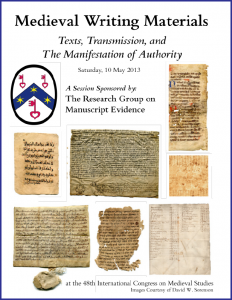 The study of writing materials is of value not only as a subject in its own right, but also as a source of information regarding the texts and images associated with them, the methods of their production, and the authority of their testimony as records of whatever sort. Continuing our series of sessions on this theme, from year to year [2011–2014 etc], this session sought to explore, develop, and advance these interlinked subjects, and to disseminate the results among many relevant (but seemingly unrelated) areas of study.
The study of writing materials is of value not only as a subject in its own right, but also as a source of information regarding the texts and images associated with them, the methods of their production, and the authority of their testimony as records of whatever sort. Continuing our series of sessions on this theme, from year to year [2011–2014 etc], this session sought to explore, develop, and advance these interlinked subjects, and to disseminate the results among many relevant (but seemingly unrelated) areas of study.
The contributions examined materials used for preparing written texts and forms of evidence for authenticating them. Italian mercantile archival resources preserved in Prato demonstrate extensive trade in writing materials. Unexpectedly useful methods for establishing the “authority” of “marginalized” – that is, isolated and often disregarded – texts and fragments as sources could emerge through careful study of the dating criteria of the Islamic paper itself on which many are written, in different languages and regions. Other reports presented case-studies of Silesian ducal charters and of the complex context for the transmission of Rhygyfarch’s ‘Lament’ of 1094 on an intrusive leaf in a twelfth-century Welsh manuscript of Cicero’s Somnium Scipionis. Our explorations across a wide range of texts, periods, and lands offered scope for interdisciplinary discourse and feedback for the development, refinement, and exchange of significant methodologies in manuscript, documentary, and related studies.
Organizer: Mildred Budny (Research Group on Manuscript Evidence)
Presider: Alan M. Stahl (Firestone Library, Princeton University)
Presenters:
- Sarah Zeiser (Harvard University)
“The Transmission of the Welsh-Latin ‘Lament’ of Rhygyfarch ap Sulien in British Library, Cotton MS Faustina C.i., Part II”
Zeiser (2013 Congress)
- Sébastien Rossignol (Dalhousie University)
“Ducal Charters and the Transformations of the Written Word in Silesia, 1200–1327”
Rossignol (2013 Congress)
- Eleanor A. Congdon (Department of History, Youngstown State University)
“Paper used in Trade in the Datini Archive (Prato)”
- David Sorenson (Quincy, Massachusetts)
“Islamic Paper: A Closer Look”
Sorenson (2013 Congress)
This Session formed the third in our annual series on “Medieval Writing Materials” at the Congress since 2011:
As before, Dr. Sorenson generously contributed the images for the posters and provided a display of original manuscript materials (on paper and vellum in various languages) for examination and discussion at the session.
[Note: The fourth Session in this series formed part of our 2014 Congress. A fifth is planned for the 2016 Congress.]
3. “Current Issues in Middle English Palaeography”
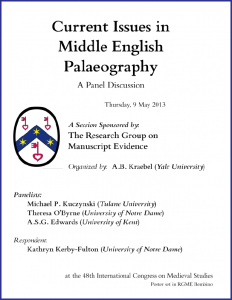 Recently the many different insights that palaeography may offer to the study of Middle English poetry and prose have taken on new clarity. Amongst many others, these include the circulation of Wycliffite literature (for example, were there such things as Lollard scribes, and what did they produce?), the role of, and audience for, Carthusian scribes (how extensively, if at all, did Carthusians disseminate literature to lay readers?), and the identity of Adam Pinkhurst (was he Chaucer’s “owen scryveyne”?). The field has benefited from the appearance, in the last few years, of various new tools for research, including Jane Roberts’ Guide to Scripts Used in English Writings (London, 2005), and the Late Medieval English Scribes project (www.medievalscribes.com), developed by Linne Mooney, Simon Horobin, and Estelle Stubbs. For this panel, contributions addressed questions of Middle English palaeography and literature, along with these and other new palaeographical tools. Our panel aimed to encourage new work in this developing and exciting field.
Recently the many different insights that palaeography may offer to the study of Middle English poetry and prose have taken on new clarity. Amongst many others, these include the circulation of Wycliffite literature (for example, were there such things as Lollard scribes, and what did they produce?), the role of, and audience for, Carthusian scribes (how extensively, if at all, did Carthusians disseminate literature to lay readers?), and the identity of Adam Pinkhurst (was he Chaucer’s “owen scryveyne”?). The field has benefited from the appearance, in the last few years, of various new tools for research, including Jane Roberts’ Guide to Scripts Used in English Writings (London, 2005), and the Late Medieval English Scribes project (www.medievalscribes.com), developed by Linne Mooney, Simon Horobin, and Estelle Stubbs. For this panel, contributions addressed questions of Middle English palaeography and literature, along with these and other new palaeographical tools. Our panel aimed to encourage new work in this developing and exciting field.
.
Organizer and Presider: Andrew B. Kraebel (Yale University)
Presenters:
- Michael P. Kuczynski (Tulane University)
“His Style or House Style? The Case of the So-Called Huntingdonshire Scribe”
- Theresa O’Byrne (University of Notre Dame)
“Documents as a Comparative Example in the Scribe B-Pynkhurst Debate”
- A.S.G. Edwards (University of Kent),
“Adam Pinkhurst, Then and Now”
Respondent: Kathryn Kerby-Fulton (University of Notre Dame)
—–
II. Session co-sponsored with King Alfred’s Notebook LLC
4. “Medieval Manuscripts in North American Collections”
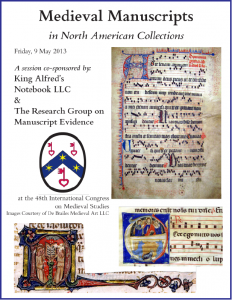 This co-sponsored session both built upon and extended our 2012 session on medieval manuscripts in the New World. Approximately 30,000 medieval and Renaissance manuscripts can be found in North American collections. Some 20,000 of these are fragmentary: single leaves, disbound bifolia and quires, or cuttings large and small. Relatively few of these sources have been examined carefully, especially at smaller college and university libraries.Moreover, American libraries have been rapidly acquiring manuscripts over the past few decades. Ohio State University has added a dozen codices and scores of leaves, the University of Pennsylvania (through the Schoenberg gift) has increased its holdings by more than one hundred codices, and the University of South Carolina has acquired five codices and sixty leaves. Even the smallest collections have undiscovered treasures, as shown by recent publications on neglected and newly recognized manuscripts, including a fragment of Ars Nova polyphony at Columbia College, South Carolina, and a Book of Hours at the Redwood Athenaeum in Newport, Rhode Island. Many manuscripts in institutional and other libraries are being digitized in order to reach a larger audience of students and scholars.
This co-sponsored session both built upon and extended our 2012 session on medieval manuscripts in the New World. Approximately 30,000 medieval and Renaissance manuscripts can be found in North American collections. Some 20,000 of these are fragmentary: single leaves, disbound bifolia and quires, or cuttings large and small. Relatively few of these sources have been examined carefully, especially at smaller college and university libraries.Moreover, American libraries have been rapidly acquiring manuscripts over the past few decades. Ohio State University has added a dozen codices and scores of leaves, the University of Pennsylvania (through the Schoenberg gift) has increased its holdings by more than one hundred codices, and the University of South Carolina has acquired five codices and sixty leaves. Even the smallest collections have undiscovered treasures, as shown by recent publications on neglected and newly recognized manuscripts, including a fragment of Ars Nova polyphony at Columbia College, South Carolina, and a Book of Hours at the Redwood Athenaeum in Newport, Rhode Island. Many manuscripts in institutional and other libraries are being digitized in order to reach a larger audience of students and scholars.
This session aimed to galvanize, present, and foster investigation into North American manuscript collections by introducing seemingly invisible archives with sources ideal for study in print or digital form. The papers addressed a variety of genres, materials, challenges, and potential for teaching and scholarship on medieval manuscripts or collections, as well as the history of collecting medieval manuscripts and fragments.
.
Organizer: Scott Gwara (University of South Carolina and King Alfred’s Notebook LLC)
.
Presider: Mildred Budny (RGME)
.
Presenters:
- John Haines (University of Toronto)
“So You Found a Medieval Book or Fragment with Music — Now What? Helpful Hints for Non-Specialists”
Haines (2013 Congress)
- Elizabeth Nyikos (University of Oxford)
“The Abbey Museum Fragment: A New Source of Fifteenth-Century English Polyphony”
Nyikos (2013 Congress)
- Justin Hastings (Loyola University Chicago)
“Newberry Library MS Case 2.5 and the Investiture Controversy”
Hastings (2013 Congress)
- B. Gregory Hays (University of Virginia)
“The Medieval Manuscripts of Edward L. Stone”
Hays (2013 Congress)
—–
III. Sessions co-sponsored with the Societas Magica
5. “Astrology and Magic”
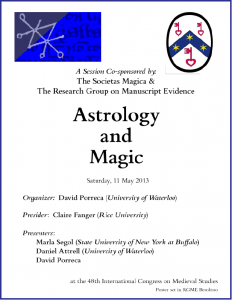 Astrology was employed in the elaboration and timing of magical ceremonies, and served as their broader cosmological backdrop. Likewise, magical and astrological treatises often traveled together in manuscript. This session was designed to open up a codicological perspective on the intersection between astrology and magic. The papers explored the links between the theoretical justifications for the functioning of magic via celestial influences — or “rays” — and the links between the material components of spells and astrological signs, lunar mansions, and/or planets.
Astrology was employed in the elaboration and timing of magical ceremonies, and served as their broader cosmological backdrop. Likewise, magical and astrological treatises often traveled together in manuscript. This session was designed to open up a codicological perspective on the intersection between astrology and magic. The papers explored the links between the theoretical justifications for the functioning of magic via celestial influences — or “rays” — and the links between the material components of spells and astrological signs, lunar mansions, and/or planets.
Organizer: David Porreca (University of Waterloo)
Presider: Claire Fanger (Rice University)
Presenters:
- Marla Segol (Skidmore College, Sarasota Springs)
“Cosmogony, Astrology, and Power in the Late-Antique Yorzer”
Abstract of Paper
- Daniel Attrell (University of Waterloo)
“High Times: Astral Magic and the Curious World of Psychoactive Substances in the Picatrix“
- David Porreca (University of Waterloo)
“What Motivated Magic? The Picatrix as a Sample of Social History”
6. “The Material Culture of Magic”
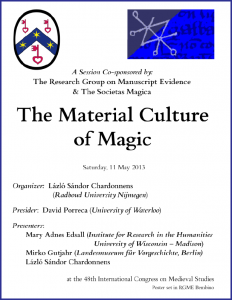 The description and conceptual visualisation of magical artefacts is well-known from medieval written sources, which sometimes dwell on procedures to make and use magical objects at length. Depending on their nature, magical artefacts themselves survive in varying numbers. Protective amulets and verbal charms made, for instance, from parchment, wax, or lead, survive in conspicuously larger numbers than objects of theurgic magic, such as the Sigillum Dei, even though the production of both groups of objects is described in detail in medieval manuals of magic. This session focused on the information which magical artefacts provide about magical practices, in addition to what the written sources tell about the construction and use of these artefacts.
The description and conceptual visualisation of magical artefacts is well-known from medieval written sources, which sometimes dwell on procedures to make and use magical objects at length. Depending on their nature, magical artefacts themselves survive in varying numbers. Protective amulets and verbal charms made, for instance, from parchment, wax, or lead, survive in conspicuously larger numbers than objects of theurgic magic, such as the Sigillum Dei, even though the production of both groups of objects is described in detail in medieval manuals of magic. This session focused on the information which magical artefacts provide about magical practices, in addition to what the written sources tell about the construction and use of these artefacts.
.
Organizer: László Sándor Chardonnens (Radboud University Nijmegen)
.
Presider: David Porreca (University of Waterloo)
.
Presenters:
- Mary Agnes Edsall (Institute for Research in the Humanities, University of Wisconsin – Madison)
“Arma Christi Roll or Textual Amulet? The Textual Evidence”
Edsall (2013 Congress)
- Mirko Gutjahr (Landesmuseum für Vorgeschichte, Halle)
“Down to Earth: The Archaeological Evidence”
Gutjahr (2013 Congress)
- László Sándor Chardonnens (Radboud University Nijmegen)
“Inscribed in Lead and Concealed in Stone: The History of a Hitherto Unknown Late-Medieval Sigillum Dei”
Abstract of Paper / Chardonnens (2013 Congress)
[Webeditor’s Update: The paper on “Carved in Lead and Concealed in Stone: A Late Medieval Sigillum Dei at Doorenburg Castle” by László Sándor Chardonnens and Jan R. Veenstra was published in Magic, Ritual, and Witchcraft, 9:2 (Winter 2014), 117–156, with illustrations. The preliminary note includes the observation that “the essay benefited from feedback on a paper the first author delivered at a Societas Magica session at the 48th International Congress on Medieval Studies at Western Michigan University, Kalamazoo, in 2013.” We would have hoped for an acknowledgment of our co-sponsorship too.]
7. “Water as Symbol, Sign, and Trial: Aquatic Semantics in the Middle Ages”
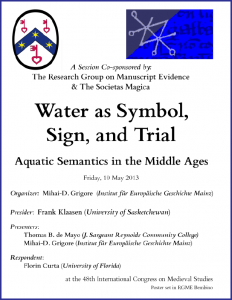 Note: This session had to be cancelled shortly before the Congress.
Note: This session had to be cancelled shortly before the Congress.
Here is how we planned it:
From its very beginnings, mankind has recognized in water an element of immense complexity and fundamental importance for life and death, for redemption or doom. Whether traditional or modern, archaic or contemporaneous, religious or secularized, many cultures over time have integrated water within their narratives, as the one of the most powerful symbolic complexes, by using it as sign of tacit or explicit desires, hopes, anxiety, and faith. The close interface with human existence and destiny directed humans to see in water, or in aquatic powers, a magical ally in their attempts to influence Fortuna.
This session was designed to consider ways in which medieval cultures across Europe conceived of water in religious, juridical, and magical valences, as manifested in attitudes and in everyday life, as well as in exceptional or emergency situations. From birth to burial, from the afterlife to the End Times, water has ever accompanied and even impacted human life not only in its physiological-material, but also in its symbolic-magical, forms. Though omnipresent, water in its semiotic ramifications within medieval cultures has not been studied adequately. Our session sought to draw attention to one of the most important and under-researched topics in the cultural history of the Middle Ages. Themes to explore included not only aquatic initiations and ordeals, visualizations of Heaven and Hell, and the symbolic topography of water and waters within the medieval imagination, but also the presence of themes, motifs, rituals, and spells involving aquatic symbolism and crafts in medieval manuscripts, inscriptions, and images.
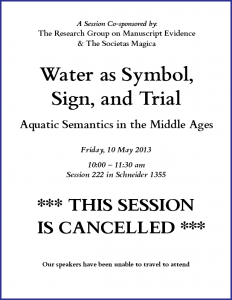 Organizer: Mihai-D. Grigore (Leibniz-Institut für Europäische Geschichte Mainz)
Organizer: Mihai-D. Grigore (Leibniz-Institut für Europäische Geschichte Mainz)
Presider: Frank Klaassen (University of Saskatchewan)
Presenters:
- Thomas B. de Mayo (J. Sargeant Reynolds Community College)
“Water as Medium of Fate in Assorted Icelandic Sagas”
De Mayo (2013 Congress)
- Mihai-D. Grigore (Leibniz-Institut für Europäische Geschichte)
“Still Waters — Running Waters: The Topography of Evil in Medieval Art and Imagery”
Grigore (2013 Congress)
Respondent: Florin Curta (University of Florida)
*****
*****
The Societas Magica also sponsored a session on “Magical Practices in Pre-Modern China” organized by Dimitri Drettas (Centre de Recherche sur les Civilisations de l’Asie Orientale, Paris). This session emerged from the response to Dimitri’s contribution to our co-sponsored session on “Dream Books” at the 2012 Congress.
*****
The full Congress program is archived as The printed program of the 48th International Congress on Medieval Studies (May 9-12, 2013), including the Corrigenda, which correct the Program attribution for the sponsorship of “Astrology and Magic” (Session 441).
The list of Societas Magica sessions is archived as Sessions and Meetings sponsored by the Societas Magica.
Information about the Congress and the Societas Magica appears on their websites:
Information about our sessions in previous and subsequent Congresses appears in the
- Archive of our activities at the International Congress on Medieval Studies
- Sponsored Conference Sessions and
- Co-sponsored Conference Sessions.
The published Abstracts are accessible through our Posts for the individual Congresses (you could search on our site for ‘X Congress’, where X=Year) and also through the Lists of Abstracts indexed
- by Authors and
- By Year.
Updates for our activities at the Congresses emerge through:
- our blog about the International Congress on Manuscript Studies
- the growing ‘Contents List’ of our Congress Activities, and
- our Facebook Page.
*****

